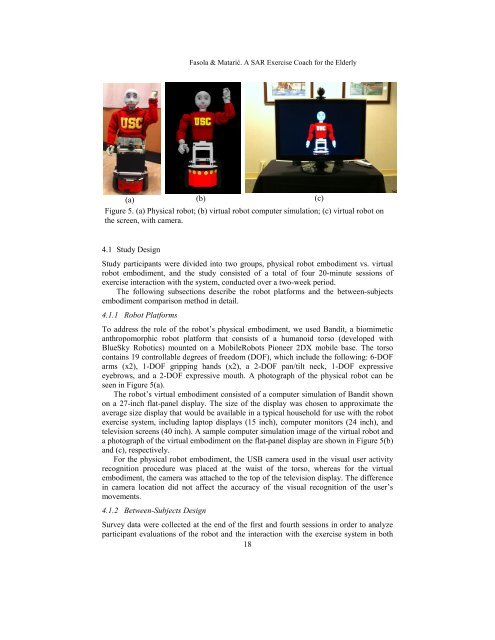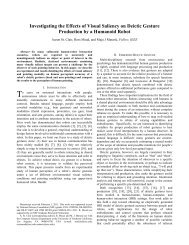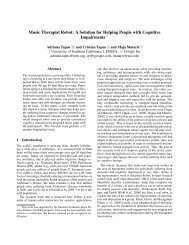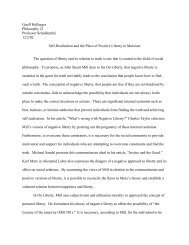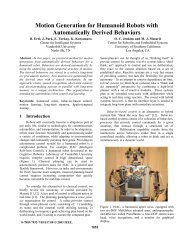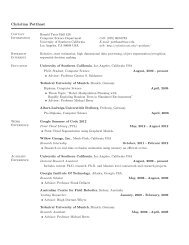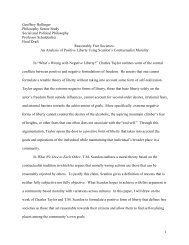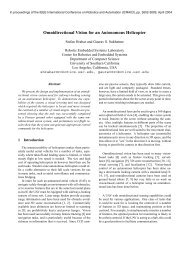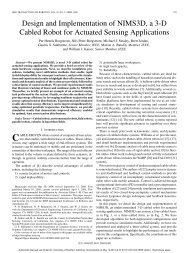Fasola & Matarić. A SAR <strong>Exercise</strong> <strong>Coach</strong> <strong>for</strong> <strong>the</strong> <strong>Elderly</strong>(a) (b) (c)Figure 5. (a) Physical robot; (b) virtual robot computer simulation; (c) virtual robot on<strong>the</strong> screen, with camera.4.1 Study DesignStudy participants were divided into two groups, physical robot embodiment vs. virtualrobot embodiment, and <strong>the</strong> study consisted of a total of four 20-minute sessions ofexercise interaction with <strong>the</strong> system, conducted over a two-week period.The following subsections describe <strong>the</strong> robot plat<strong>for</strong>ms and <strong>the</strong> between-subjectsembodiment comparison method in detail.4.1.1 <strong>Robot</strong> Plat<strong>for</strong>msTo address <strong>the</strong> role of <strong>the</strong> robot’s physical embodiment, we used Bandit, a biomimeticanthropomorphic robot plat<strong>for</strong>m that consists of a humanoid torso (developed withBlueSky <strong>Robot</strong>ics) mounted on a Mobile<strong>Robot</strong>s Pioneer 2DX mobile base. The torsocontains 19 controllable degrees of freedom (DOF), which include <strong>the</strong> following: 6-DOFarms (x2), 1-DOF gripping hands (x2), a 2-DOF pan/tilt neck, 1-DOF expressiveeyebrows, and a 2-DOF expressive mouth. A photograph of <strong>the</strong> physical robot can beseen in Figure 5(a).The robot’s virtual embodiment consisted of a computer simulation of Bandit shownon a 27-inch flat-panel display. The size of <strong>the</strong> display was chosen to approximate <strong>the</strong>average size display that would be available in a typical household <strong>for</strong> use with <strong>the</strong> robotexercise system, including laptop displays (15 inch), computer monitors (24 inch), andtelevision screens (40 inch). A sample computer simulation image of <strong>the</strong> virtual robot anda photograph of <strong>the</strong> virtual embodiment on <strong>the</strong> flat-panel display are shown in Figure 5(b)and (c), respectively.For <strong>the</strong> physical robot embodiment, <strong>the</strong> USB camera used in <strong>the</strong> visual user activityrecognition procedure was placed at <strong>the</strong> waist of <strong>the</strong> torso, whereas <strong>for</strong> <strong>the</strong> virtualembodiment, <strong>the</strong> camera was attached to <strong>the</strong> top of <strong>the</strong> television display. The differencein camera location did not affect <strong>the</strong> accuracy of <strong>the</strong> visual recognition of <strong>the</strong> user’smovements.4.1.2 Between-Subjects DesignSurvey data were collected at <strong>the</strong> end of <strong>the</strong> first and fourth sessions in order to analyzeparticipant evaluations of <strong>the</strong> robot and <strong>the</strong> interaction with <strong>the</strong> exercise system in both18
Fasola & Matarić. A SAR <strong>Exercise</strong> <strong>Coach</strong> <strong>for</strong> <strong>the</strong> <strong>Elderly</strong>conditions over time. Data ga<strong>the</strong>red from <strong>the</strong> first and fourth session post-session surveyswere analyzed using a two-tailed independent two-sample T-test assuming unequalvariances to test <strong>for</strong> significant differences among <strong>the</strong> participant evaluations of <strong>the</strong> robotand <strong>the</strong> interaction across both conditions. Survey results from <strong>the</strong> fourth session wereused to per<strong>for</strong>m <strong>the</strong> final comparison analysis, as <strong>the</strong>y were less likely to contain scoresinfluenced by <strong>the</strong> effect of novelty.4.2 Participant StatisticsWe recruited elderly individuals to participate in <strong>the</strong> study through a partnership withbe.group, an organization of senior living communities in Sou<strong>the</strong>rn Cali<strong>for</strong>nia, usingflyers and word-of-mouth. We offered a $50 Target gift card to those willing toparticipate in all four sessions of <strong>the</strong> study. Thirty-seven people responded, of whom fourwere omitted due to inconsistent/incorrect answers to survey questions that were used toidentify questionable survey results. Thus, <strong>the</strong>re were a total of 33 participants whosedata were analyzed. Half of <strong>the</strong> participants were placed in <strong>the</strong> physical robot group (n =16), and <strong>the</strong> o<strong>the</strong>r half were placed in <strong>the</strong> virtual robot group (n = 17). The samplepopulation consisted of 27 female participants (82%) and 6 male participants (18%).Participants’ ages ranged from 68–88, and <strong>the</strong> average age was 76 (SD = 6.32).4.3 Measures4.3.1 Evaluation of InteractionThere were two dependent measures used to evaluate <strong>the</strong> interaction with <strong>the</strong> robotexercise system. The first measure was <strong>the</strong> enjoyableness of <strong>the</strong> interaction, collectedfrom participant assessments of <strong>the</strong> interaction according to six adjectives: enjoyable,interesting, fun, satisfying, entertaining, boring, and exciting (Cronbach’s α = .92).Participants were asked to rate how well each adjective described <strong>the</strong> interaction on a 10-point scale, anchored by “Describes Very Poorly” (1) and “Describes Very Well” (10).Ratings <strong>for</strong> <strong>the</strong> adjective “boring” were inverted to keep consistency with <strong>the</strong> o<strong>the</strong>radjectives that reflect higher scores as being more positive.The second measure was <strong>the</strong> perceived value or usefulness of <strong>the</strong> interaction.Similarly, participants were asked to evaluate how well each of <strong>the</strong> following fouradjectives described <strong>the</strong> interaction: useful, beneficial, valuable, and helpful (Cronbach’sα = .96). The same 10-point scale anchored by “Describes Very Poorly” (1) and“Describes Very Well” (10) was used in <strong>the</strong> evaluation.4.3.2 Evaluation of <strong>Robot</strong>Companionship of <strong>the</strong> robot was measured from participant responses to nine 10-pointsemantic differential scales concerning <strong>the</strong> following robot descriptions: bad/good, notloving/loving, not friendly/friendly, not cuddly/cuddly, cold/warm, unpleasant/pleasant,cruel/kind, bitter/sweet, and distant/close (Cronbach’s α = .89). These questions werederived from <strong>the</strong> Companion Animal Bonding Scale of Poresky, Hendrix, Mosier, andSamuelson (1987). The companionship of <strong>the</strong> robot was measured to assess potential useracceptance of <strong>the</strong> robot as an in-home companion, <strong>the</strong>reby demonstrating <strong>the</strong> capabilityof <strong>the</strong> system to facilitate independent living.Participants evaluated <strong>the</strong> helpfulness of <strong>the</strong> robot by rating four robot characteristicson a 10-point scale: useful, valuable, beneficial, and helpful (Cronbach’s α = .96). Therating scale was anchored by “Not at all” (1) and “Absolutely” (10). Using <strong>the</strong> same19


